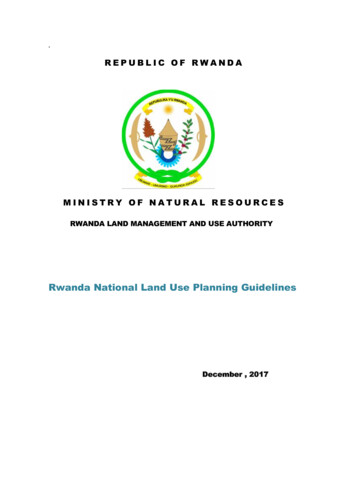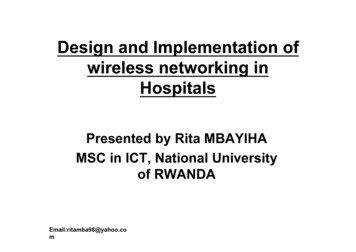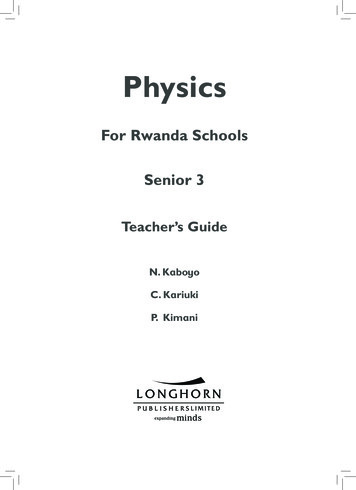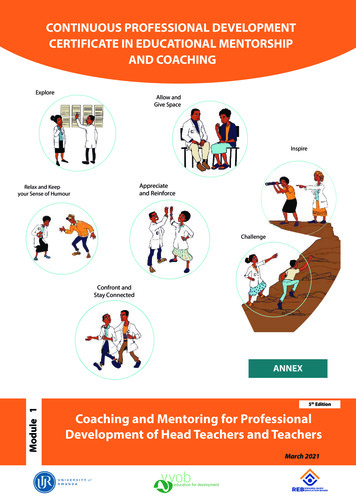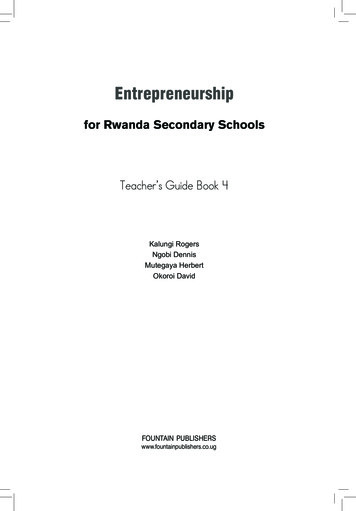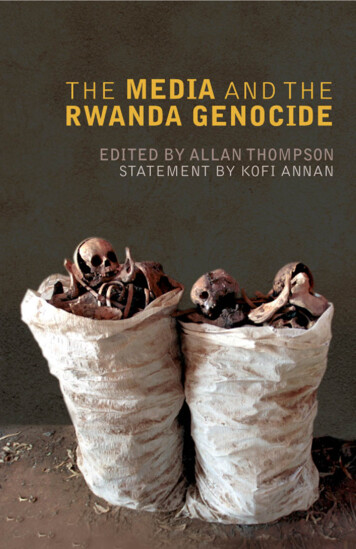
Transcription
The Media and the Rwanda Genocide
This page intentionally left blank
THE MEDIA ANDTHE RWANDA GENOCIDEEdited byAllan ThompsonWith a Statement byKofi AnnanPlutoPPressLONDON ANN ARBOR, MIFountain PublishersKAMPALA, UGANDAInternational Development Research CentreOTTAWA CAIRO DAKAR MONTEVIDEO NAIROBI NEW DELHI SINGAPORE
First published 2007 by Pluto Press345 Archway Road, London N6 5AAand 839 Greene Street, Ann Arbor, MI 48106www.plutobooks.comInternational Development Research CentrePO Box 8500, Ottawa, ON, Canada K1G 3H9www.idrc.ca/info@idrc.caISBN 1–55250–338–0 (e-book)Fountain Publishers LtdFountain House, 55 Nkrumah Road, P.O. Box 488, Kampala, Ugandawww.fountainpublishers.co.ugE-mail: fountain@starcom.co.ugISBN-10 9970–02–595–3ISBN-13 978–9970–02–595–4Copyright Allan Thompson, 2007. Statement by Kofi Annan, 2007The right of Allan Thompson to be identified as the author of this work has been asserted byhim in accordance with the Copyright, Designs and Patents Act 1988.British Library Cataloguing in Publication DataA catalogue record for this book is available from the British LibraryHardbackISBN-13 978 0 7453 2626 9ISBN-10 0 7453 2626 9PaperbackISBN-13 978 0 7453 2625 2ISBN-10 0 7453 2625 0Library of Congress Cataloging in Publication Data applied for10987654321Designed and produced for Pluto Press byChase Publishing Services Ltd, Fortescue, Sidmouth, EX10 9QG, EnglandTypeset from disk by Stanford DTP Services, NorthamptonPrinted and bound in India
ContentsMessage to Symposium on the Media and the Rwanda GenocideKofi AnnanPrefaceNotes on Contributors1 IntroductionAllan Thompsonixxixiii12 The Media DichotomyRoméo Dallaire123 Rwanda: Walking the Road to GenocideGerald Caplan20PART ONE: HATE MEDIA IN RWANDA4 Call to Genocide: Radio in Rwanda, 1994Alison Des Forges415 RTLM Propaganda: the Democratic AlibiJean-Pierre Chrétien556 Kangura: the Triumph of Propaganda RefinedMarcel Kabanda627 Rwandan Private Print Media on the Eve of the GenocideJean-Marie Vianney Higiro738 Echoes of Violence: Considerations on Radio and Genocidein RwandaDarryl Li9 RTLM: the Medium that Became a Tool for Mass MurderMary Kimani10 The Effect of RTLM’s Rhetoric of Ethnic Hatred in RuralRwandaCharles Mironko11 Journalism in a Time of Hate MediaThomas Kamilindi90110125136PART TWO: INTERNATIONAL MEDIA COVERAGE OF THEGENOCIDE12 Reporting the GenocideMark Doyle145
viCONTENTS13 Who Failed in Rwanda, Journalists or the Media?Anne Chaon16014 Reporting Rwanda: the Media and the Aid AgenciesLindsey Hilsum16715 Limited Vision: How Both the American Media andGovernment Failed RwandaSteven Livingston16 Missing the Story: the Media and the Rwanda GenocideLinda Melvern17 What Did They Say? African Media Coverage of the First 100Days of the Rwanda CrisisEmmanuel C. Alozie18819821118 Exhibit 467: Genocide Through a Camera LensNick Hughes23119 Media Failure over Rwanda’s GenocideTom Giles23520 A Genocide Without Images: White Film NoirsEdgar Roskis23821 Notes on Circumstances that Facilitate Genocide: the AttentionGiven to Rwanda by the Media and Others Outside RwandaBefore 1990Mike Dottridge24222 The Media’s Failure: a Reflection on the Rwanda GenocideRichard Dowden24823 How the Media missed the Rwanda GenocideAlan J. Kuperman25624 An Analysis of News Magazine Coverage of the Rwanda Crisisin the United StatesMelissa Wall261PART THREE: JOURNALISM AS GENOCIDE – THE MEDIA TRIAL25 The Verdict: Summary Judgement from the Media Trial27726 The Pre-Genocide Case Against Radio-Télévision Libre desMilles CollinesSimone Monasebian30827 The Challenges in Prosecuting Print Media for Incitement toGenocideCharity Kagwi-Ndungu330
viiCONTENTS28 ‘Hate Media’ – Crimes Against Humanity and Genocide:Opportunities Missed by the International Criminal Tribunalfor RwandaJean-Marie Biju-Duval29 A Lost Opportunity for Justice: Why Did the ICTR NotProsecute Gender Propaganda?Binaifer Nowrojee343362PART FOUR: AFTER THE GENOCIDE AND THE WAY FORWARD30 Intervening to Prevent Genocidal Violence: the Role of the MediaFrank Chalk31 Information in Crisis Areas as a Tool for Peace: the HirondelleExperiencePhilippe Dahinden37538132 The Use and Abuse of Media in Vulnerable SocietiesMark Frohardt and Jonathan Temin38933 Censorship and Propaganda in Post-Genocide RwandaLars Waldorf40434 PG – Parental Guidance or Portrayal of Genocide:the Comparative Depiction of Mass Murder in ContemporaryCinemaMichael Dorland41735 The Responsibility to Report: a New Journalistic ParadigmAllan Thompson433BibliographyIndex447455
This page intentionally left blank
UNITED NATIONSNATIONS UNIESTHE SECRETARY-GENERAL--MESSAGE TO SYMPOSIUM ON THE MEDIAAND THE RWANDA GENOCIDECarleton University School of Journalism and CommunicationOttawa, 13 March 2004When, on 7 April, people around the world commemorate the 10thanniversary of the Rwanda genocide, that observance should be filled not onlywith remorse, but with resolve.We must remember the victims – the hundreds of thousands of men, womenand children abandoned to systematic slaughter while the world, whichhad the capacity to save most of them, failed to save more than a handful,forever sullying the collective conscience. We must also help the survivors stillstruggling with the physical and psychological scars. But most of all, we mustpledge – to ourselves as moral beings and to each other as a human community– to act boldly, including through military action when no other course willwork, to ensure that such a denial of our common humanity is never allowedto happen again.The United Nations has now had ten years to reflect on the bitter knowledgethat genocide happened while UN peacekeepers were on the ground in Rwanda,and to learn lessons that all humankind should have learned from previousgenocides. We are determined to sound the alarm about emerging crises andto help countries tackle the root causes of their problems. I expect soon toappoint a United Nations special adviser on the prevention of genocide, andto make other proposals for strengthening our action in this area.It is encouraging to know that the news media are also undertaking a processof self-examination as we collectively remember this tragedy. Media were usedin Rwanda to spread hatred, to dehumanize people, and even to guide thegenocidaires toward their victims. Three journalists have even been foundguilty of genocide, incitement to genocide, conspiracy and crimes againsthumanity by the International Criminal Tribunal for Rwanda. We must finda way to respond to such abuses of power without violating the principles offreedom, which are an indispensable cornerstone of democracy.I am glad that you are confronting these and other questions, including therole of the international media, especially at a school where future journalistsare being trained. Such training must include reflection on the responsibilitiesof their chosen profession.There can be no more important issue, and no more binding obligation,than the prevention of genocide. The world has made some progress inix
xMESSAGE FROM KOFI ANNANunderstanding the responsibility to protect. Yet it is still not clear, were thesigns of impending genocide to be seen somewhere today, that the worldwould mount an effective response. I hope that all of us, as diplomats,journalists, government officials or just concerned citizens, will act promptlyand effectively, each within our sphere of influence, to halt genocide whereverit occurs – or better still, to make sure there is no ‘next time’.
PrefaceIt was the French philosopher, Voltaire, who wrote: ‘We owe respect to theliving; to the dead we owe only truth.’In the case of the 1994 genocide in Rwanda, the news media accomplishedneither of Voltaire’s admonitions. Confronted by Rwanda’s horrors, Westernnews media for the most part turned away, then muddled the story whenthey did pay attention. And hate media organs in Rwanda – through theirjournalists, broadcasters and media executives – played an instrumentalrole in laying the groundwork for genocide, then actively participated in theextermination campaign.On the eve of the tenth anniversary of the Rwanda genocide, the Schoolof Journalism and Communication at Carleton University in Ottawa hosteda one-day symposium on 13 March 2004, entitled ‘The Media and theRwanda Genocide.’ The symposium examined in tandem the role of boththe international media and Rwanda’s domestic news organizations in thecataclysmic events of 1994. The Carleton symposium brought together for thefirst time an international collection of experts as well as some of the actorsfrom the Rwandan drama; it also inspired this collection of papers. Many ofthe contributions found here are based on papers delivered at the Carletonevent, but others were commissioned or have been reprinted here because oftheir valuable contribution to the debate.The symposium was made possible by generous contributions from theInternational Development Research Centre (IDRC) and the Government ofCanada, through the Global Issues Bureau of the Foreign Affairs departmentand the Canadian International Development Agency. The IDRC hasalso played a key role in the publication of this collection; it continues tosupport Carleton’s efforts to build a Media and Genocide Archive and toestablish a partnership with the School of Journalism and Communicationat the National University of Rwanda in Butare through a project called TheRwanda Initiative.I would like to thank all those who contributed to the symposium and tothis collection, most notably the authors of the papers you are about to read.Special thanks are due to Chris Dornan, who was director of the School ofJournalism and Communication when this project began, Pamela Scholey andBill Carman from the IDRC, Roméo Dallaire, who lent considerable moralsupport to this project, and Sandra Garland, who did wonderful work as acopy-editor. Finally, I would like to thank my wife Roula El-Rifai and ourson, Laith Rifai-Thompson. My passion for Rwanda has often consumedtime and energy that should have been devoted to my family.For my part, I came to Rwanda late. Before joining the faculty at Carletonin 2003, I was a career journalist with the Toronto Star. I was not in Rwandaxi
xiiPREFACEin 1994. I first visited in 1996 to report on the repatriation of Hutu refugeesfrom the Goma region of what was then eastern Zaire. But Rwanda does getinside you and, since then, I think I have been trying to some degree to makeamends for not having been there in 1994. Reviewing the Toronto Star archives,I found an article of mine published on 9 April 1994. I had forgotten everhaving written it; perhaps it left my memory because it was such a dreadfulpiece of journalism. Written three days into the genocide, the article focusedentirely on the evacuation of Canadian expatriates from Kigali and invokedevery cliché of tribal conflict, chaos and anarchy.Two months later, in early June, while Roméo Dallaire and his beleagueredcontingent watched helplessly as the slaughter continued in Rwanda, Ireported for the Star from Normandy, France, where then Canadian PrimeMinister Jean Chrétien was participating in ceremonies to mark the fiftiethanniversary of D-Day. In my experience, major events taking place elsewherein the world often become a preoccupation for the journalists reporting onsuch international gatherings. But as I recall, during that weekend of speechesand press conferences in Normandy commemorating a war that ended halfa century earlier, there was nary a mention of what was going on at thatmoment in Rwanda. None of the leaders mentioned the Rwanda genocide.Nor did any in the media throng covering the D-Day commemorations askabout Rwanda.The collection you are about to read explores the role of hate media in theRwanda genocide and examines international media coverage of the genocide.Then it turns to an assessment of the guilty verdict in the international criminaltribunal for Rwanda’s ‘Media Trial’ and finally concludes with a section on theaftermath, examining the current media climate in Rwanda, media interventionstrategies and the place of the Rwanda genocide in popular culture.The purpose of looking back at the media’s role in the Rwanda events isnot just to remember. We still have some learning to do on this subject andexamining the way journalists and news organizations conducted themselvesin 1994 is not just a historical exercise. Sadly, we don’t yet seem to have fullydiscerned or absorbed the lessons from Rwanda.Ultimately, this collection is dedicated to those who perished in 1994. Tounderline the point, I would like to borrow a comparison used by Britishjournalist, Scott Peterson. To understand the number of dead, imagine thatevery word in this book is the name of a victim. This entire volume wouldlist only 200,000 of the dead, a fraction of the estimated toll of nearly onemillion people. As you read this collection, look at every word. Then think ofsomeone you know.Allan ThompsonOttawa, 2006
Notes on ContributorsEmmanuel C. Alozie is university professor of media communications atGovernors State University, University Park, Illinois. His research interests arein development communication, international/cultural journalism, advertisingand public relations. Alozie is former assistant editor with DemocraticCommuniqué, author of Cultural Reflections and the Role of Advertising inthe Socio-economic and National Development of Nigeria (2005, Edwin MellenPress), and co-edited, Toward the Common Good: Perspectives in InternationalPublic Relations (2004, Ally & Bacon).Jean-Marie Biju-Duval is a Paris-based lawyer who was engaged as the defencecounsel for Ferdinand Nahimana, the former Rwandan media executive whowas convicted in the Media Trial.Gerald Caplan is a leading Canadian authority on genocide prevention. Heis the author of Rwanda: The Preventable Genocide, the 2000 report of theInternational Panel of Eminent Personalities appointed by the Organizationof African Unity to investigate the 1994 Rwanda genocide. He is also founderof Remembering Rwanda, the Rwanda genocide tenth anniversary memorialproject and has developed and teaches a course on the role of the media in theRwanda genocide.Frank Chalk is a professor in the Department of History, Concordia University,Montreal, Canada, and the co-director of the Montreal Institute for Genocideand Human Rights Studies. He is co-author (with Kurt Jonassohn) of TheHistory and Sociology of Genocide.Anne Chaon is a journalist with Agence France-Presse (AFP). In the firstweeks of the 1994 Rwanda genocide, she was based in Paris, working on AFP’sAfrica desk. She reported from Rwanda for AFP in June, before heading toeastern Zaire in July of that year. She testified against RTLM media executiveFerdinand Nahimana in Paris and before the International Criminal Tribunalfor Rwanda in the Media Trial.Jean-Pierre Chrétien is a historian and co-author of Rwanda: les médias duGénocide. He has held teaching positions at l’École normale supérieure duBurundi, l’Université de Lille III, and since 1973 has been a researcher inAfrican history at the Centre National de la Recherche Scientifique (CNRS)in Paris.Philippe Dahinden is a Swiss journalist who is cofounder of and formereditor-in-chief at the Hirondelle Foundation, an international organizationxiii
xivNOTES ON CONTRIBUTORSof journalists that establishes media operations in crisis areas. He foundedand managed the independent radio station, Radio Agatashya, which coveredRwanda, Burundi and the Kivu after July 1994 in an attempt to counter thedestructive messages of hate radio. He also set up and managed Radio Okapiin the Democratic Republic of Congo.Roméo Dallaire is a retired Lieutenant-General. He led the United NationsAssistance Mission for Rwanda (UNAMIR) to help implement the Arushaaccords. He is the author of Shake Hands with the Devil: The Failure ofHumanity in Rwanda and now sits in the Senate of Canada as a member of theLiberal party.Michael Dorland is professor of communication in the School of Journalismand Communication at Carleton University. A former film critic before hisreturn to the academy in 1992, his current research concerns the medicalaspects of Holocaust survival.Mike Dottridge was a desk officer with Amnesty International during the 1980s,covering Rwanda and other countries in the Great Lakes region. At the time ofthe genocide (and until 1995) he was supervising Amnesty’s work throughoutsub-Saharan Africa. He is currently a consultant on human rights issues.Richard Dowden was Africa editor for a British newspaper, the Independent, in1994. He is now director of the Royal African Society.Mark Doyle has worked for the BBC since 1986 and was its east Africacorrespondent in 1993–94. He spent much of the period of the genocide inRwanda and, on several occasions, he was the only foreign reporter in Kigali.Alison Des Forges is senior advisor to the Africa division of Human RightsWatch. She is also the author of Leave None to Tell the Story: Genocide inRwanda and has served as expert witness in genocide proceedings at theInternational Criminal Tribunal for Rwanda, U.S. Federal Court, and inBelgian and Swiss courts.Mark Frohardt is Internews Network’s regional director for Africa and formerdeputy chief of mission for the United Nations Human Rights Field Operationin Rwanda (May 1995 to June 1997).Tom Giles covered the Rwanda genocide as a producer for BBC News. Hewon a Royal Television Society award in ‘international current affairs’ for hisPanorama production on the war in Iraq – In the Line of Fire.Jean-Marie Vianney Higiro is an associate professor in the Departmentof Communication at Western New England College in Springfield,Massachusetts. From 31 July 1993 to 6 April 1994, he was director of theRwandan Information Office (ORINFOR) in Kigali.
NOTES ON CONTRIBUTORSxvLindsey Hilsum was one of only two Western journalists on the ground inRwanda at the time of the genocide and is in a unique position to describemedia coverage of the genocide and the disproportionate attention paid to theplight of Hutu refugees who had fled to Goma. She is China correspondentfor Channel 4 News in Britain.Nick Hughes is a British director/cameraman who captured some of the onlyknown media images of killings during the 1994 genocide in Rwanda. He latertestified as a prosecution witness before the International Criminal Tribunalfor Rwanda, where his footage was entered as a piece of evidence, exhibit 467,in the trial of George Rutaganda. Hughes later produced the film 100 Days,the first cinematic treatment of the Rwanda genocide.Marcel Kabanda is a Rwandan historian and a consultant with the UnitedNations Educational, Scientific and Cultural Organization (UNESCO) inParis. He is also a co-author of Rwanda: les médias du Genocide.Charity Kagwi-Ndungu is a trial attorney with the United Nations InternationalCriminal Tribunal for Rwanda and was a prosecutor in the Media Trial.Thomas Kamilindi is a former Radio Rwanda journalist, based in Kigali. Heresigned a few months before the genocide started. He was among the manyliberal Hutus accused of sympathizing with the Tutsi-led rebel forces of theRwandan Patriotic Front and narrowly escaped death during the genocide. In2005, he left Rwanda, where he had been working as a BBC correspondent, toaccept a Knight-Wallace Fellowship at the University of Michigan.Mary Kimani is a journalist who covered the Media Trial and conducted aseries of interviews with an RTLM journalist. The work reported in this volumeformed part of a thesis completed for a master’s degree in communicationpsychology at the University of Warnborough, Canterbury, United Kingdom.Alan Kuperman is assistant professor at the LBJ School of Public Affairs,University of Texas at Austin.Darryl Li is completing a PhD in Anthropology and Middle Eastern Studiesat Harvard University and a JD at Yale Law School. In three months offieldwork, he explored the impact of RTLM on its listeners by interviewingdozens of Rwandans who were part of the station’s audience and who admittedto taking part in the genocide.Steven Livingston is associate professor of political communication and international affairs and director, School of Media and Public Affairs, The GeorgeWashington University.Linda Melvern is an investigative journalist and author of A People Betrayed:The Role of the West in Rwanda’s Genocide and Conspiracy to Murder: TheRwandan Genocide.
xviNOTES ON CONTRIBUTORSCharles Mironko is a cultural anthropologist whose work focuses on genocideperpetrators. He was formerly Associate Director of the Genocide StudiesProgram at Yale University, and chief of the Culture Section at the Organizationof African Unity. He is currently a Humanitarian Officer in Darfur, under theAfrican Union Mission in Sudan.Simone Monasebian was a trial attorney with the United Nations InternationalCriminal Tribunal for Rwanda and one of the prosecutors in the Media Trial.Later, she was principal defender at the Sierra Leone tribunal before herappointment as chief of the New York office of the United Nations Office onDrugs and Crime as well as a CourtTV legal analyst.Binaifer Nowrojee is Lecturer on Law at Harvard Law School. She wascounsel with Human Rights Watch/Africa and the author of the HumanRights Watch report, Shattered Lives: Sexual Violence during the RwandanGenocide and its Aftermath. She has testified as an expert witness before theInternational Criminal Tribunal for Rwanda on sexual violence and in 2005became director of the Open Society Initiative for East Africa.Edgar Roskis (1952–2003) was a journalist with Le Monde diplomatique anda senior lecturer in the Department of Information and Communication,Université Paris-X, Nanterre, France.Jonathan Temin is a senior programme officer with the CHF International andformer programme associate with Internews Network.Lars Waldorf is currently affiliated with the World Policy Institute at TheNew School. From 2002 to 2004, he ran Human Rights Watch’s field officein Rwanda. He is now writing a book on the genocide trials before Rwanda’scommunity courts (gacaca).Melissa Wall is a journalism professor at California State University,Northridge. A former journalist, she has trained journalists in Ethiopia andresearched township newspapers in Zimbabwe.Allan Thompson is a professor at Carleton University’s School of Journalismand Communication. He joined the faculty at Carleton in 2003 after spending17 years as a reporter with the Toronto Star, Canada’s largest circulationdaily newspaper. He worked for a decade as a correspondent for the Star onParliament Hill in Ottawa and also undertook frequent reporting assignmentsin Africa, reporting from Rwanda a number of times. At Carleton, he leads theRwanda Initiative, a media capacity-building partnership with the journalismschool at the National University of Rwanda.
1IntroductionAllan ThompsonThe images are so disturbing they are difficult to watch. Two women kneelamid the bodies of those who have already been slain. They are at the side ofa dirt road in Kigali, the capital of Rwanda. Their final moments are capturedon video by a British journalist, one of only a few foreign reporters left in thecountry, who is recording clandestinely from the top of a building nearby.1Remarkably, during a genocide that claimed as many as a million lives, this isone of the only times a killing is recorded by the media. In the footage, one ofthe women is pleading, first clasping her hands in front of her, as if in prayer,then throwing open her arms, appealing to the throng of men who are millingabout nearby, holding machetes and sticks. Further along the road are thebodies of others who have been dragged out of their homes and killed. Thewoman continues to beg, but the men seem to be oblivious to her. A youngboy dressed in a T-shirt strolls past, giving the women only a backward glance.At one point, you can see a man in the crowd clutching something in his lefthand. It appears to be a radio.Minutes go by and the woman continues to plead for her life. The otherfigure crouched beside her barely flinches. Men wielding sticks in one hand andmachetes in the other move forward and begin to pound the bodies that arestrewn around the two women, striking the corpses again and again. One mangives the bodies a final crack, as if driving a stake into the ground, then slingshis stick over his shoulder and ambles off. All the while, the woman continues towave her arms and plead. A white pickup truck approaches and drives throughthe scene. The windshield wipers are flopping back and forth. One of the menhuddled in the back of the vehicle waves a hand at the woman who is kneelingon the ground. He taunts her with a greeting.Finally, two other men approach. One, dressed in dark trousers and a whiteshirt, winds up to strike the pleading woman. He has the posture of someonewho is about to whip an animal. She recoils. Then he strikes her on the headwith the stick he is clutching in his right hand. She crumples to the ground,then suffers more blows from her murderer. Almost at the same moment, theother woman is struck down as well by another assailant, her head very nearlylopped off by the initial blow. Finally, the two men walk away casually, leavingthe bodies to squirm. In the distance, there is the sound of birdsong.The date is 18 April 1994, nearly two weeks after the 6 April plane crashthat claimed the life of Rwandan President Juvénal Habyarimana and plunged1
2INTRODUCTIONRwanda into the abyss. The tiny central African country, a mere dot on theworld map, garnered virtually no international media attention before the killingspree that followed the president’s death. No one had paid much attention toa fledgling peace accord signed in Arusha, Tanzania in 1993, setting out thedetails for a power-sharing arrangement between the majority Hutu populationand the minority Tutsi, represented in the talks by the rebels from the Tutsidominated Rwandan Patriotic Front (RPF). An international peacekeepingforce, commanded by a Canadian general, Roméo Dallaire, was dispatchedto oversee implementation of the accord. Dallaire and his peacekeepers wereonly vaguely aware of the mounting tensions in the autumn of 1993, but heardrumblings about a ‘third force’ – Hutu extremists who opposed the powersharing arrangement.The voice of Hutu Power was the private radio station RTLM, establishedby extremists who surrounded the president. And RTLM was an echo of otherextremist media, notably the newspaper Kangura. Once the president’s plane wasshot down by unknown assailants, the message from RTLM was unmistakable:the Tutsi were to blame; they were the enemy and Rwanda would be betteroff without them. The killings began almost immediately in Kigali throughthe night of 6–7 April. Hutu moderates, who were willing to share power,were among the first targeted, along with Tutsi marked for extermination in acampaign that eventually fanned out across the country. Many of the hundredsof thousands of Rwandans who were slaughtered had huddled in churches forsanctuary. Death squads lobbed in grenades. In their frenzy, killers severed theAchilles tendons on the heels of their victims, so they could return and finishthe job later. Teachers killed students, neighbours slaughtered neighbours aslocal officials helped organize the killing.In its 2003 verdict in the ‘Media Trial’ of executives from RTLM andKangura, the International Criminal Tribunal for Rwanda (ICTR) confirmedthe undoubted role of Rwandan hate media in the killing:The newspaper and the radio explicitly and repeatedly, in fact relentlessly,targeted the Tutsi population for destruction. Demonizing the Tutsi as havinginherently evil qualities, equating the ethnic group with ‘the enemy’ andportraying its women as seductive enemy agents, the media called for theextermination of the Tutsi ethnic group as a response to the political threatthat they associated with Tutsi ethnicity. (ICTR 2003: para. 72)(The full text of the judgement summary can be found in Part Three of thiscollection.)Most international news organizations initially misunderstood the natureof the killing in Rwanda, portraying it as the result of tribal warfare, ratherthan genocide. Much of the international coverage focused on the scramble toevacuate expatriates from the country. In mid-April, when the killing intensified,the volume of news reports actually declined. Most journalists had left alongwith the other foreigners.
INTRODUCTION3The grainy video captured on 18 April by Nick Hughes, who was positionedon the top floor of the French School, is truly the exception that proves therule. Hughes looked first through the scope of a rocket launcher, borrowedfrom a Belgian soldier stationed in the school. Then he trained his camera onwhat he saw taking place in the road below. Hughes would recount later that hehad to stop shooting at several points for fear that his lone remaining batterypack would expire and, as a result, there are ‘jump cuts’ in the video at pointswhen he briefly turned off his camera. Because he was shooting from such adistance, the sound on the audio track is the background noise in the schooland, occasionally, the voice of Hughes and an associate. ‘She’s praying overthe person that has just been killed,’ he comments at one point. ‘They’re goingto kill her, you can see that,’ he says later.Eventually, the international media reports on Rwanda were replete withimages of bloated corpses, strewn at the roadside or choking Rwanda’s rivers.But because there were so few foreign journalists on the ground at the heightof the killing and because the domestic media had either been cowed or coopted into the massacres, there are no other known images of the crime itself,the crime of genocide. Would the world have reacted differently if confronteddaily by images of people being slaughtered rather than the static, disembodiedpictures of disfigured corpses? More info
of Journalism and Communication at Carleton University in Ottawa hosted a one-day symposium on 13 March 2004, entitled ‘The Media and the Rwanda Genocide.’ The symposium examined in tandem the role of both the international media and Rwanda’s domes
